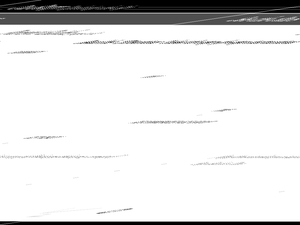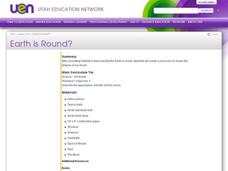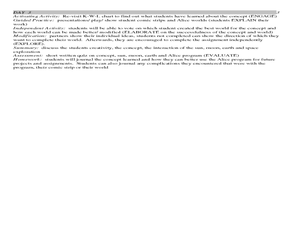Curated OER
Time Travel to the Edge of the Universe and Back!
Students analyze the size of the universe and calculate the time to travel to near and distant destinations.
Curated OER
Visual Vocabulary
Students use context clues to determine an understanding for vocabulary words in texts. In this vocabulary lesson plan, students recognize linguistic features in their readings to help them to figure out words.
Curated OER
Follow the Falling Meteorite
Students use triangulation method to locate meteorite landing site on the map. In this earth science lesson, students participate in a meteorite treasure hunt set up by the teacher. They explain how this method is used by scientists to...
Curated OER
Exploring Space Fact
Students visit web sites to gather information about space and space exploration.
Curated OER
Follow the Sun
Learners use a simple model of the Earth and Sun as seen from space to explore the sun's apparent movement across the sky over the course of a day and year. They consider the apparent direction of movement and changes in the sun's angle.
Curated OER
See the Stars
Students explore the nighttime sky. In this space science instructional activity, students read the book Maria's Comet and and investigate the sky using their naked eyes. Students compare the view of their naked eyes to the view of a...
Curated OER
Meteor Showers
Students use the Internet to discover the wonderful world of comets and meteor showers. They discover how to spot one and predict them using a calendar. They also examine the makeup of meteoroids and meteorites.
Curated OER
Blue Moon
Students explore information about the moon. In this trans-disciplinary lesson plan, students first listen to a picture book about the moon, then create an accompanying art project to illustrate a blue moon. Finally, the students write...
Curated OER
Paper Plate Observation
Students analyze transits from previous scientists. They identify simple objects that could have been used for documentation in the science world. They also practice scientific inquiry using methodology.
Curated OER
Science as a Source of Social Controversy
Students research the two opposing views and biographical information about Ptolemy and Copernicus in order to be familiar with the societal viewpoints that influenced the thinking of these two scientists. Students role-play supporters...
Curated OER
The Sun
Students draw diagram of sun and its layers, including photosphere, chromosphere, corona, convection and radiative zones, and core. Students then describe each layer in their own words, define sun spot cycle, and describe solar flares.
Curated OER
Earth is Round?
Third graders discuss how Aristotle concluded that the Earth was round. As a class, they review theories about the Earth's shape and describe how life on Earth would be different if it were flat. Individually, they make a moon book in...
Curated OER
My Hometown
Students identify the basic requirements needed for survival and identify the resouces needed for survival that are found within their own community. They use craft materials to create a model of it and then. create a color key to...
Curated OER
The Drake Equation
Students use the Drake Equation to calculate the probability of sustaining life on various planets. Through the use of the equation, they determine whether intelligent and advanced civilizations can be developed on planets other than...
Curated OER
What are Stars?
Students research the solar system and it's characteristics. In this solar system lesson, students are broken into 4 groups, each assigned a specific part of the solar system. Students use the Internet to research their part...
Curated OER
Super Gelatin
Students measure angles of refraction as the light travels through gelatin. In this experimental lesson students complete a refraction lab and plot their data.
Curated OER
Astonishing Planetary Discovery
Students access the Internet, research one of the planets, copy and paste necessary information, and design a creature that would survive for a year on their planet. They present their creature and its qualities to the rest of the class.
Curated OER
Starring...Bears!
Students illustrate a First Nations' legend. In this legend of bears lesson, students read several legends which involve bears and groups of stars or constellations. After reading, students illustrate portions of the stories....
Curated OER
What On Earth
Learners explore earth science through concept mapping, discussion, and self-discovery.
Curated OER
Facts and Myths about our Solar System
Sixth graders explore popular ideas about the Sun and Moon. In this space science lesson plan, 6th graders separate commonly accepted details about our solar system into facts and myths. Students research a particular idea...
Curated OER
Reasons for Seasons
Students track photoperiod (daylight hours) over time and predict how daylight change during different seasons. This helps build their understanding that ever-changing daylight is the driving force for migrations and all other seasonal...
Curated OER
Sky Pictures
Young scholars investigate constellations. In this space science lesson, students view transparencies of constellations and identify the zodiac constellations. Young scholars research the legends connected with the constellations.
Curated OER
Fractions, Decimals, and Gravity
Learners discuss how weight is directly related to gravitational force on a planet. Students then choose Space Traveler as companion and compute how much their guide weighs on various planets, based on each planet's relative surface...
Curated OER
High in the Sky
Sixth graders explore the concept of constellations. In this constellations lesson, 6th graders research Internet and print sources regarding constellations, particularly those that are named for mythological creatures. Students compose...

























